The Napa River has long been known for as the spot with the warmest weather in closest proximity to San Francisco. There’s a full-service marina and boatyard—perhaps the only one with wineries nearby—one restaurant with a guest dock, and a yacht club.
Unfortunately, there is no protected anchorage along the river, and no guest docks near downtown. The river also has its share of hazards, in the form or rocks and debris that is just below mid-tide and generally not well marked (more on this later in this article).
Getting to the River
Assuming you’re coming from the central bay, head north under the San Rafael Bridge, and then head east once you’re clear of Pinole Point. Head for the Carquinez Bridge at the entrance of the Carquinez Strait. Before you get to the bridge, though, turn to port to head up the Mare Island Strait.
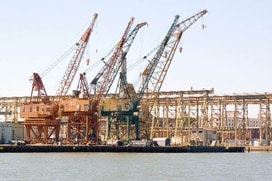
Mare Island will be to port, and the city of Vallejo to starboard. If you’re looking for a place to stop, the Napa Valley Marina is your best bet (unless you’re a yacht club member, in which case the Napa Valley Yacht Club is another option.)
Mare Island, once the largest naval shipyard on the west coast but closed since 1996, provides lots of nautical sightseeing, from still-active naval vessels to an aircraft carrier and passenger ship being scrapped. The island is gradually being cleaned up and redeveloped. In time, there will no doubt be facilities here for visiting boaters, but today there are not; the docks are strictly off limits.
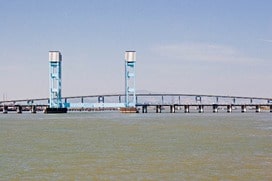
At the north end of the Mare Island Strait, you’ll come to the Mare Island Causeway Bridge, which has a clearance of only 12 feet when down but 100 feet when raised (both measurements at high water). So unless you’re in a runabout or express cruiser, you’ll need the bridge opened. Call the bridge tender on Channel 13 or by phone at 707.562.3556. The bridge is manned from 9 am to 7 pm, seven days a week. If you want the bridge opened outside of those hours, call and provide at least two hours advance notice. Just past the Mare Island Causeway Bridge is the fixed Highway 37 bridge, which has plenty of clearance.
Once you’re past these two bridges, you’ll be in the wide lower section of the Napa River. It’s time to start paying close attention to the chart and the navigation markers, since the navigable part of the river is much narrower than the visible width. There’s not much to see, and no place to stop, in this section of the river. Off to port, there’s a couple of flooded islands behind the breached levee.
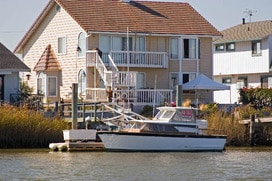
After a few miles, the river narrows. To port you’ll see a long series of waterfront homes, ranging from very funky to quite fancy, most with their own docks. These homes are on Milton Road, which runs south from the Napa Valley Marina along the river. Keep to the port side of the river, as there’s some shallow water and unmarked hazards at a few places along the eastern shore. Note that this begins a long no-wake zone, from marker 13 to the Cutting’s Wharf launch ramp.
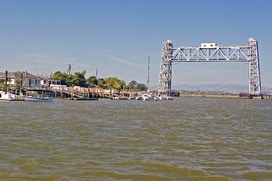
You’ll pass under the Brazos railroad bridge, which stays in the upper position (with 98 feet of clearance) except when a train is passing through. The homes along the left shore continue for about three-fourths of a mile, until you reach the Napa Valley Marina (to port).
Stopping for the Night
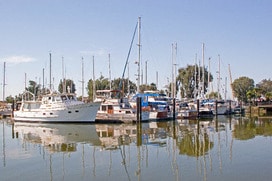
The
Power and water are available, and when you register for your guest slip, you’ll get a bathroom key. There’s a store that is a combination chandlery and mini-market, as well as picnic tables and even a Bocce Ball court. But if you’re looking for a restaurant, you’ll have to take a cab into town, which is a 15-minute drive away.
You may well want to consider the Napa Valley Marina as your final river destination, as there are significant hazards. But if you’re feeling adventurous, and your boat insurance is paid up, it is an interesting cruise to downtown. You may be able to get a spot at the Napa Valley Yacht Club’s guest dock, which is much closer to downtown than is the marina.
Into the Upper River, Carefully
Just past the marina, also to port, is the Cuttings Wharf launch ramp and Moore’s Landing Restaurant. Further up the river, there’s an abundance of egrets, herons, and other water and shore birds.
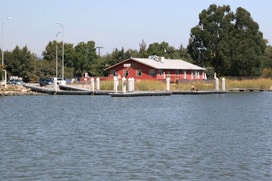
It is possible to anchor along the river between Cuttings Wharf and the Highway 12/129 bridge, but you should be prepared to move should a barge come along. Fortunately, the barges generally don’t travel at night.
Once you’re past the Cuttings Wharf ramp, you’re entering the more treacherous upper reaches of the river. As long as you’re in the channel, there’s plenty of water, even at low tide, and it is certainly possible to navigate the river safely. However, there’s shoals, rocks, and debris as well, and it is often unmarked. Although you might think high tide is the best time to go, the opposite is true: the river is safest at low tide, when the hazards are more visible.
The U.S. Army Corps of Engineers’ massive Napa River Flood Control project included widening the river in places to help prevent flooding in downtown Napa. No doubt this is a great project for protecting the city, but it has made the river less attractive and more dangerous. There are many shoals and hazards that are below water at mid-tide — but only barely.
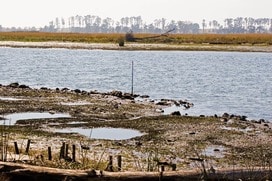
This is especially true in places where the Corps of Engineers has created “flood terraces,” which are places where the old levee was scraped away to widen the river. The navigable channel was not affected, but now the visible river is wider (especially above mid-tide), and the areas above the flood terraces are very shallow. Unlike almost everywhere else in the Bay and Delta, where running aground typically means being stuck in soft mud, the Napa River bites back. The flood terraces also are not soft mud, as one would expect at the edge of a river, but include lots of rock.
Some of the flood terraces are clearly (but minimally) marked by the channel markers, and there are some private markers as well. But there’s places where there are rocks just outside the line of the markers, with hundreds of feet between markers. And there’s many places where the shoals and hazards aren’t marked at all.
There is, incidentally, a good reason why the flood terraces were left at mid-tide height, and not lower (which would have been safer for boats). The plan is for the terraces to support plant growth that is adapted for this sometimes submerged, sometimes above-water environment. It is part of the ecological restoration aspect of the flood control project.
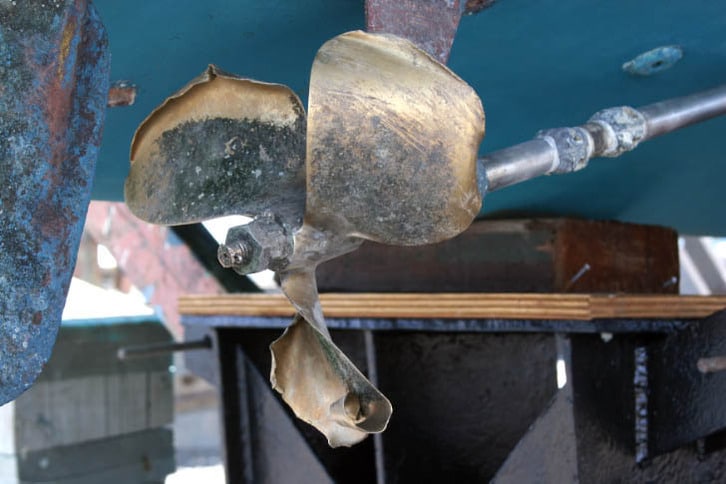
This photo shows what can happen if you stray into one of these areas. We had our most expensive boating incident ever just north of Kennedy Park, right along the line between the two green markers.
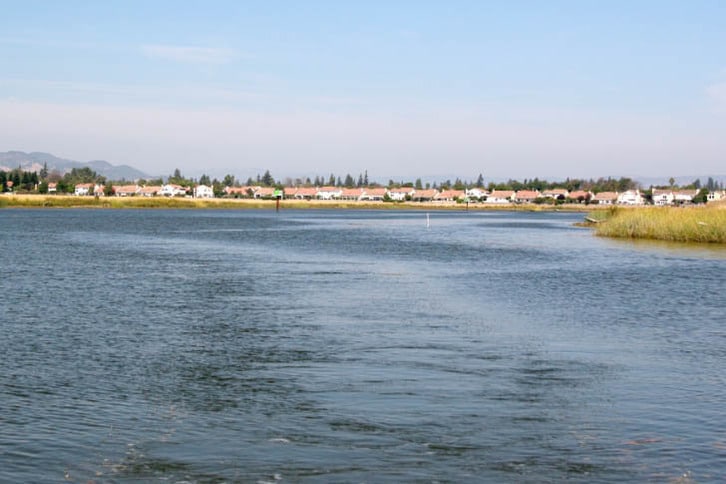
This is the spot where we ran into trouble. We were coming down-river, just about where the small boat in this photo is (coming toward the point from which this picture was taken). We passed the green marker 25 (barely visible at the upper center of this photo), sitting right on the bank, indicating that the channel ran right along the shore at that point. A minute later, we noticed that the next marker, green 23, was directly ahead of us, perhaps 200 feet away and 20 feet from shore. Noticing that this marker was not all the way at the bank, we started to turn to port, when the most awful noises began.
Thankfully, we were able to limp back to the Napa Valley Marina, where the crew there did an excellent job replacing both our props, replacing one strut, getting the shafts straightened, and patching up a little fiberglass damage. Thanks to our Boat U.S. insurance, we were only out a few hundred dollars, but it cost the insurance company about $6,000, and it cost us nearly a month of prime boating time.
The folks at the boatyard expressed no surprise at our plight. “We have boats coming in like this all the time” commented one yard manager. Another staffer bitterly remarked that “the Corps of Engineers has ruined the river.”
We can only blame ourselves for our accident, as we did probably drift just over the line between the markers. And we don’t doubt that the Corps of Engineers is working diligently to fix Napa’s serious flooding problems, and that this (and ecological restoration) is their priority. More should be done, though, to make the river safer for boating—primarily adding more markers (which is the Coast Guard’s responsibility).
To safely traverse the river, keep a close watch on the markers and on your depth sounder. If possible, head upriver at low tide, when the flood terraces are visible. Keep well clear of the line between markers; drifting just a few feet over the line could result in major damage. When there are markers along only one bank, stay away from the other bank; the lack of markers does not mean that it is deep all the way to the shore. The dredged channel is 70 feet wide, and only one side is marked. So the best bet is to day about 20 or 30 feet away from the marked edge.
On to Downtown
As you head upriver, there’s a plethora of shorebirds and waterbirds, including egrets, herons, sandpipers, and loons. There’s no place to stop, however, other than the yacht club.
Note that from marker 25 to downtown is a no-wake zone.
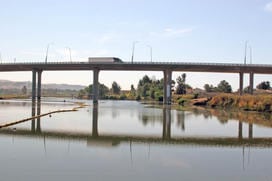
About a mile south of downtown, this fixed bridge marks the end of the river for large sailboats, which will not be able to reach the yacht club.
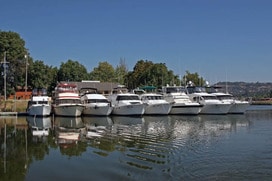
The yacht club has a 180-foot guest dock and welcomes visitors, even if they are not a member of a reciprocal club. On days such as the one pictured here, with a large cruise-in group from another club, the dock may be full, so be sure to call ahead.
After many years of development, downtown Napa finally has an accessible waterfront. The boat dock, which was removed in 2005, was replaced in 2013.
A huge floodwall was built around the Napa Mill complex at 5th and Main streets. You can go a few hundred yards past the floodwall, to the fixed bridge over 3rd Street, which marks the end of the navigable river (except for small boats) and the start of Napa Creek. There’s no dredging north of 3rd Street.
Thanks to Robin Klingbeil, Bill Newton, and Jon Lander for their assistance with this article.
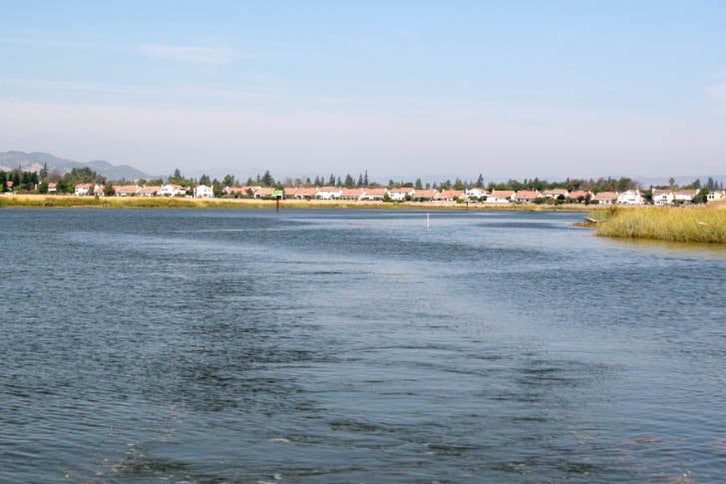
Great article, thanks for sharing. Were you not using your plotter when you ran aground? Curious on the accuracy of the plotter in the more dicy areas. Cheers,
It would be beneficial if Napa River gets a cleaning job so that shallow draft boats could make it from SF to Napa safely.